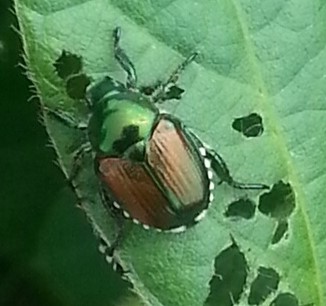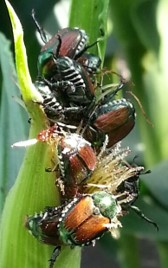Japanese beetles can feed on more than 300 plant species, causing extensive damage in a variety of environments.
But it’s the harm these pests can do to corn and soybean crops that growers need to keep an eye on.
When to watch out for Japanese beetles
The lifecycle of Japanese beetles involves one generation per year, and their schedule is usually predictable. These pests start out as larvae in the soil, and they’ll stay there, feeding on roots, from August until June of the following year.
In June, adults will begin to emerge. They’ll spend the summer eating, mating and laying more eggs. A female Japanese beetle can lay 40 to 60 eggs in her life, so a population can get out of control quickly.

How to spot Japanese beetles
Although there are other beetles that have some similar features, Japanese beetles are fairly distinctive. They have a metallic green head with long antennae, bronze wing covers and six white hair tufts on each side of their body. An adult Japanese beetle will measure about a half-inch long.
Before adults emerge, however, it’s still possible to spot these pests. Larvae are creamy colored, C-shaped grubs about 1 to 1-1/8 inches long with a rusty brown head and a small V of hairs on their rasters.
What kind of damage can Japanese beetles do?

Japanese beetles can be incredibly destructive to fields, plants and possibly even yields. After emerging, adults can feed on 300+ host plants. They especially love ornamentals and fruit trees, and can chew through foliage and even the f
ruits themselves. They “skeletonize,” or chew leaf tissue around the veins, leaving holes throughout.
But these beetles can also cause damage in corn and soybean fields. Most of this destruction will usually be contained on the outside edges, rarely extending throughout the entire field.
Japanese beetles sometimes feed on corn plant leaves or even exposed kernels. But most of their attention in cornfields is focused on silk clipping.
In soybean fields, Japanese beetles feed on leaf tissue and can cause defoliation.
How to protect fields from Japanese beetles
Some specific corn and soybean hybrids can provide increased resistance against pests, so talk to a trusted agronomist to choose the best option.
In some cases of a Japanese beetle infestation, it might be time for treatment.
In soybean fields, consider treatment if there’s been 30% defoliation during the vegetative stages, or 15-20% during the reproductive stages.
For cornfields, treatment might be necessary if silks are down to less than ½” and pollination is less than 50% complete. Further damage could keep the rest of a corn crop from being pollinated, which can impact yield.
Several insecticide options can reduce Japanese beetle populations. Speak with a trusted agronomist to choose the right one, and make sure to follow all labels to ensure correct application. Just keep an eye on neighboring fields to make sure adult beetles haven’t migrated and infested a different location after an insecticide application.
The bottom line
Japanese beetles are versatile in terms of what they feed on — and are one of the most widespread insect pests in the U.S. corn and soybeans are just two of the 300+ plant types these beetles feed on.
Keep an eye out for skeletonized leaves, defoliation in soybeans or silk clipping in corn. Focus attention on the edges of fields, rather than the middle, as this is where Japanese beetles concentrate their efforts. If damage passes a certain threshold (30% defoliation in soybeans or corn silks clipped to ½” or lower), consider an insecticide treatment.
For questions about Japanese beetles or how to best protect fields from insect pests, reach out to an AgriGold agronomist.

